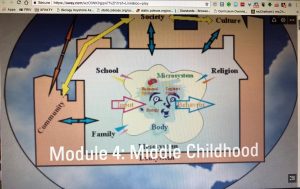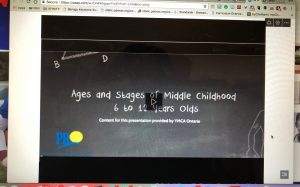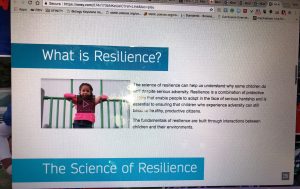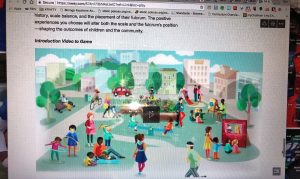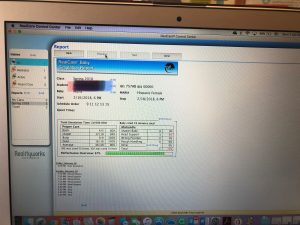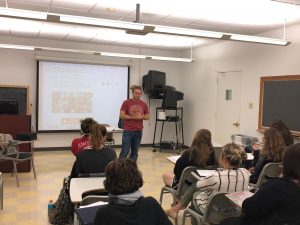Project Overview
My primary goal was to increase student learning and engagement by integrating innovative ways to communicate and disseminate information through exploring technology tie-ins to instruction, assessment, and presentations. I wanted my courses to provide an opportunity for students to explore culturally responsive educational practices and professional development learning experiences through social media platforms that are best for teachers to communicate with their future students, families, and the community.
Learning is no longer only defined by time and place. A wide variety of digital networks, platforms, and content resources are being created to personalize learning to ensure that the interests and values of the whole child are being met. I approach my work to transform teaching by equipping students to work in diverse learning ecosystems with children and their families. To date, I have used Sway, Twitter, video and audio equipment, and Reality Works Real Care Baby Simulator to increase student engagement through active learning and reflection.
Planning Process
During the Summer of 2017, the Technology Fellows summer professional development series provided exposure to instructional technologies and time to reflect on how we would redesign our courses with instructional supports and technology enhancements. We learned about a myriad of technology platforms, applications, and software to increase student learning and engagement. As I begin to explore and try out the new technologies through a trial run, I could not settle on just one technology tie-in to integrate into my courses. Therefore, I used a multifaceted interactive technological approach to incorporate into my courses.
Implementation
During Fall 2017, I taught a new course online, EDU 606/607: Child Development and Adolescent Learning Theory. This course focuses on child development in the context of social, cultural, and instructional settings and how these factors play into learning theory. Students apply knowledge of developmental stages to create authentic classroom learning environments that are healthy, respectful, supportive, challenging by utilizing culturally responsive instructional techniques. I used the interactive platform, Sway to make the information and text more engaging. The purpose of Sway is to convey concepts quickly, easily and clearly. Unlike PowerPoint, it is primarily for presenting ideas onscreen rather than to an audience. Sway allowed me to integrate text, articles, and video into one interactive Word document so students did not have to click on multiple documents or folders to access the weekly course content.
Below are examples of Sway documents that I created for class.
Sway Example: Module 4A-Middle Childhood
Sway Example: Module 4B-Middle Childhood
(Click on the pictures below to view them larger)
This Spring 2018, the two courses that I decided to focus on were EDU 105: Child Development Birth through Grade 4 and EDU 505 Issues of Poverty and Race in Education. I partnered with Saturday Light Brigade to provide the audio recording equipment for my students to record their learning experiences. SLB Radio Productions, Inc. (SLB) uses radio and audio to encourage, amplify, share and archive the ideas, stories, and feelings of children, youth and families. They provide an innovative method to promote increased creative expression, critical thinking, and technical curiosity.
EDU 105 is a required course for PreK-4 education undergraduate students; however, it is open to other undergraduate majors as well. This course focuses on child development in the context of social, cultural, and instructional settings and how these factors play into learning theory. Students apply knowledge of developmental stages to create authentic classroom learning environments that are healthy, respectful, supportive, challenging by utilizing culturally responsive instructional techniques. I integrated the Reality works Real Care Baby Simulator project to provide a simulation experience of how a real baby acts. The students had to care for the baby as if it were real over a 48 period. They had to change, rock, feed and burp the baby.
Below are pictures of our project (Click on the pictures below to view them larger).
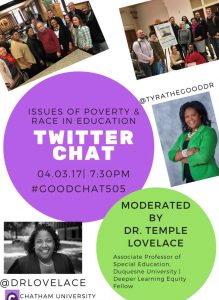
EDU 505 is a course taken by secondary education graduate students that focuses on the characteristics and effects of poverty and race in education through examining types of poverty and racial biases in schools, as well as the impact of poverty on cognitive and physical development.
I wanted to build upon the social media engagement that I incorporated into this course the previous semester. In this course, the students had to write weekly reflections after each class session on Twitter. We also had a course culminating Twitter Chat that will be held again this semester.
The students share strategies they learned during the semester to equip educators, parents and the community in ways to address issues of poverty and race in education. You can search #GOODChat505 on Twitter to see our class reflections.
Below are examples of our Twitter posts (Click on the pictures below to view them larger).
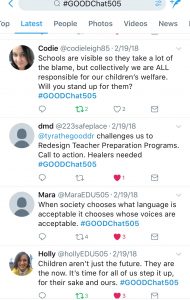 |
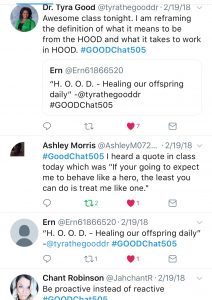 |
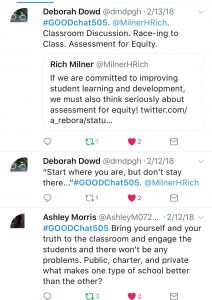 |
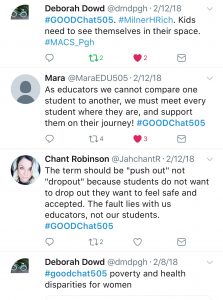 |
|---|
Assessment
EDU 606/607: Child and Adolescent Development and Learning Theories
The students completed an open-ended questionnaire at the end of the semester to gather feedback on using SWAY for their weekly class information and assignments. The questions focused on the effectiveness and ease of the interactive document and whether or not it increased their engagement in the online course. Most of the students thought the Sway format was simple to navigate, appreciated the flow of the assignments and graphics, and indicated that they would consider using the tool in their own classroom teaching.
Questionnaire:
Please describe your thoughts about using the interactive SWAY’s that contained the weekly module focused content.
• Was the tool effective?
• Was it easy/hard to follow?
• Did it increase your engagement in the course?
• Did you enjoy learning this way? (Using One interactive Word Document)
• Should any content had been added or deleted from the SWAY’s? If so, please explain.
• Would you consider using a SWAY document in your classes as a classroom teacher?
EDU 105: Child Development: Birth through Grade 4
While engaged in the baby simulation, the students had to document their experiences through pictures, journal entries, and Vlogs. I was able to monitor their progress through the Reality Works Real Care Baby Simulator software. The students had to discuss and present their experience in class according to the learning outcomes.
EDU 505: Issues of Poverty and Race in Education
The students are encouraged to tag the authors of our course readings and other educational leaders to share their learning or to ask questions either for clarification or rhetorical when doing their Twitter postings. Although some students were reluctant in the beginning of the course, many students ended up embracing this reflective learning exercise. They become excited and more engaged when their Tweets were “Liked” or re-twitted by educational scholars, legislatures, or community leaders. Our class Twitter Chat for this semester is scheduled for April 2nd.
Reflections and Next Steps
In reflecting on my use of interactive technology tools that I integrated into my three courses over this past academic year, I believe that there was greater student engagement because of the hands-on software and digital educational resources that were used. I appreciated learning ways to keep me engaged and excited in teaching the courses. The Sway document not only was a success with the students, but helped me to organize my course materials more efficiently. The simulation baby project provided a project-based learning experience that is essential to the education major students on their journey to developing competencies in teaching. The use of Twitter in my course allowed me to connect my love for the social media platform to increase student engagement while they shared their learning publicly. I was able to instantly gauge the students’ comfort and knowledge after each class session. Sharing their thoughts and reflections via Twitter allowed the students to become a part of an online community of learners focused on equity in education. I plan to continue using the Reality Works Real Care Baby Simulator, and expand the integration of Twitter and SWAY into my other courses.
